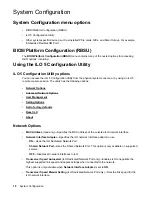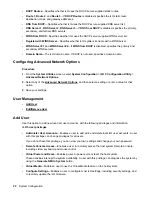
UEFI System Utilities
The UEFI System Utilities is embedded in the system ROM. Its features enable you to perform a wide
range of configuration activities, including:
• Configuring system devices and installed options.
• Enabling and disabling system features.
• Displaying system information.
• Selecting the primary boot controller or partition.
• Configuring memory options.
• Launching other preboot environments.
HPE servers with UEFI can provide:
• Support for boot partitions larger than 2.2 TB. Such configurations could previously only be used for
boot drives when using RAID solutions.
• Secure Boot that enables the system firmware, option card firmware, operating systems, and software
collaborate to enhance platform security.
• UEFI Graphical User Interface (GUI)
• An Embedded UEFI Shell that provides a preboot environment for running scripts and tools.
• Boot support for option cards that only support a UEFI option ROM.
What is UEFI?
Unified Extensible Firmware Interface (UEFI) defines the interface between the operating system and
platform firmware during the boot, or start-up process. Compared to BIOS, UEFI supports advanced pre-
boot user interfaces. The UEFI network stack enables implementation on a richer network-based OS
deployment environment while still supporting traditional PXE deployments. UEFI supports both IPv4 and
IPv6 networks. In addition, features such as Secure Boot enable platform vendors to implement an OS-
agnostic approach to securing systems in the pre-boot environment.
The ROM-Based Setup Utility (RBSU) functionality is available from the UEFI interface along with
additional configuration options.
12
UEFI System Utilities













































